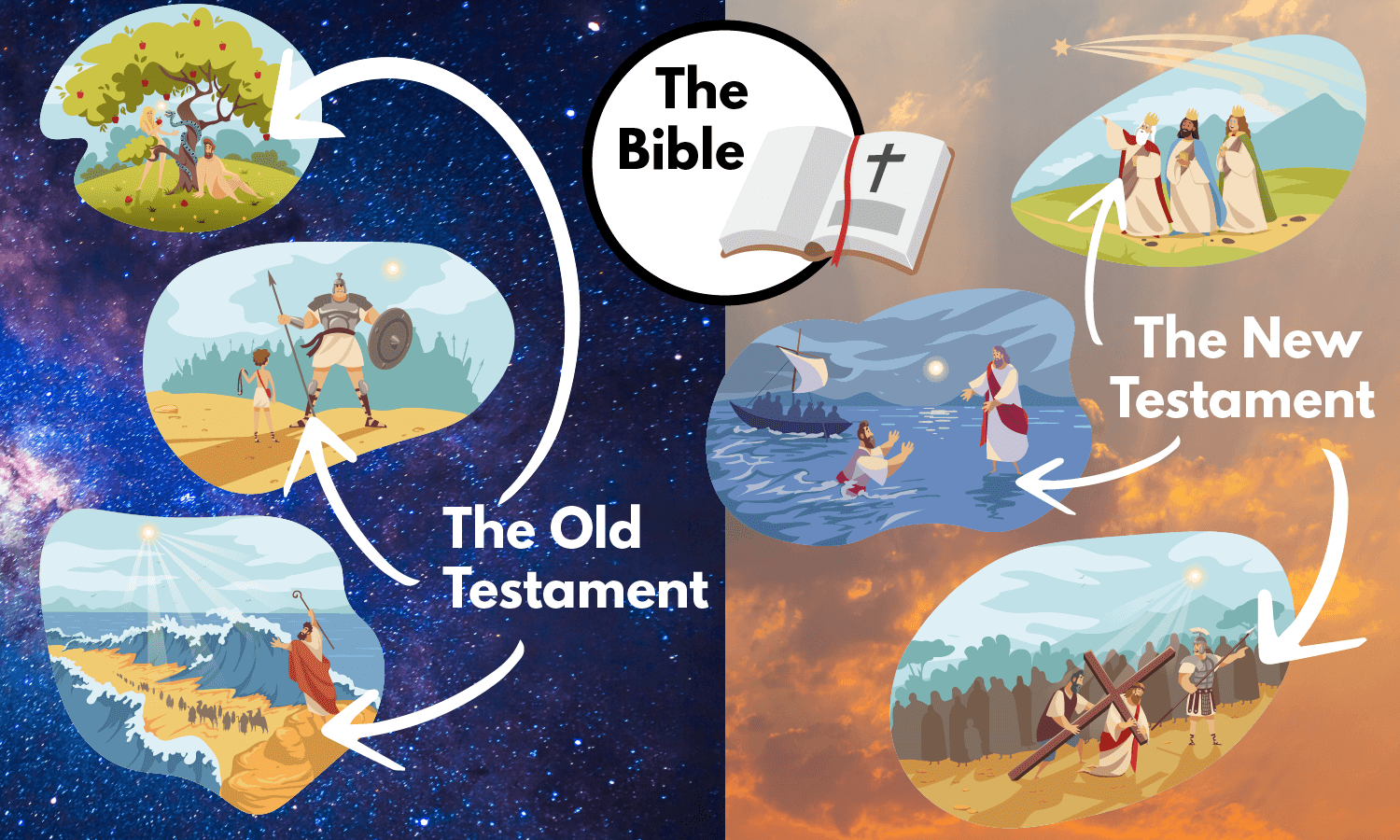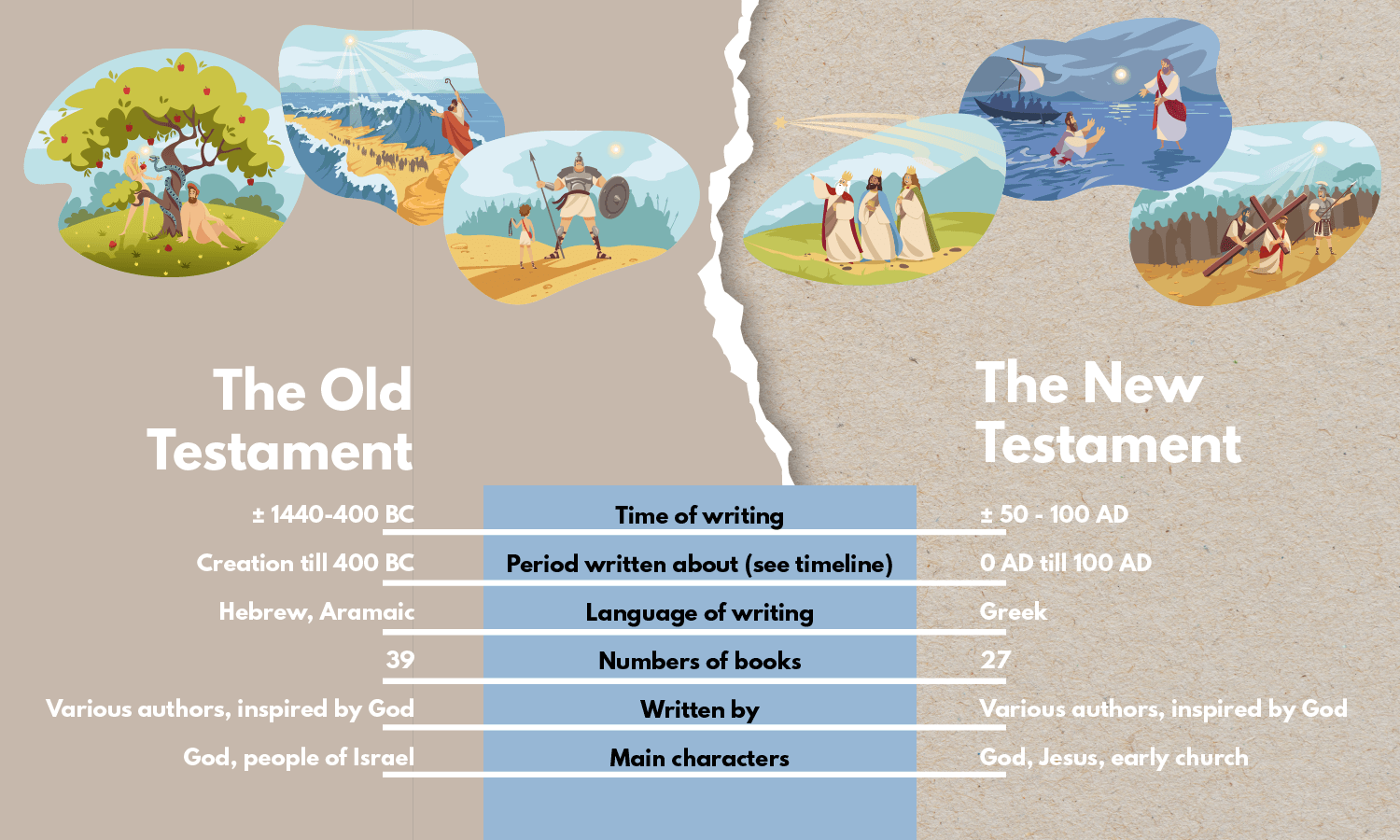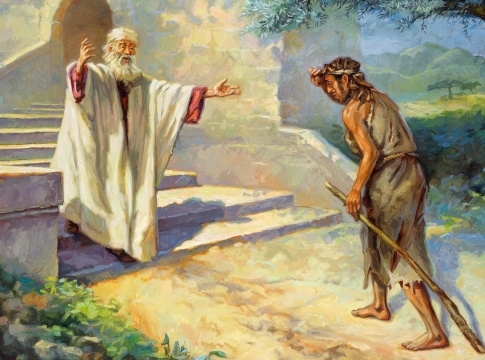
The Bible, which is God’s sacred Word, is divided into two parts: the Old Testament (OT) and the New Testament (NT). Despite being referred to as “old,” the ancient Testament is neither obsolete nor useless. Furthermore, the New Testament is already almost two millennia old. The contents and distinctions between the Old and New Testaments are explained in this article.
- Short overview
- In English, the word “testament” mostly refers to a legal document that describes how someone’s earthly possessions should be dispensed after their death. The Bible uses the word “testament” in this way as well (see Hebrews 9:16–17), but only rarely. Most of the time, the meaning is different.
- What does the word “testament” mean?
- What do the words “Old Testament” and “New Testament” mean?
- The Old Testament
- What is the outline of the Old Testament?
- What is the message of the Old Testament?
- The people of Israel as God’s people
- Who wrote the Old Testament?
- When was the Old Testament written or put together?
- Why is the Old Testament important?
- Who believes in the Old Testament?
- The time between the Old and the New Testament
- The New Testament
- The relationship between the Old and the New Testament
- Conclusion
Short overview

In English, the word “testament” mostly refers to a legal document that describes how someone’s earthly possessions should be dispensed after their death. The Bible uses the word “testament” in this way as well (see Hebrews 9:16–17), but only rarely. Most of the time, the meaning is different.
What does the word “testament” mean?
The word “testament” in the Bible most frequently refers to a covenant, which is an agreement between two people, or a dispensation, which are significant periods of time during which God has dealt with people in various ways.
What do the words “Old Testament” and “New Testament” mean?
The two main sections of the Bible are the Old and New Testaments. All of the writings written during the first dispensation—that is, during the period of [God’s covenant agreement] with humanity in general and with the people of Israel in particular, where the law was significant—are found in the Old Testament (see Exodus 24:8; 34:10).
Based on the atoning work of Jesus Christ, God established a new covenant with humanity that is described in the New Testament as a new dispensation. The prophet Jeremiah had already predicted this new covenant (see Jeremiah 31:31-34; Hebrews 8:6-8).
In the remainder of this piece, we’ll go into greater detail about:
- The Old Testament
- The New Testament
- The relationship between the two Testaments
The Old Testament
What is the outline of the Old Testament?
There are 39 distinct books in the Old Testament, some of which can be read as “part 1” and “part 2” of a larger book. Three main genres can be distinguished among these books:
- Historical books: they begin with creation and primarily concentrate on the history of the Israelites and God’s actions toward them.
- Poetic books or writings: songs, proverbs and poems.
- Books of prophecy are divine messages, mostly addressed to the Israelites.
See “What are the Old Testament Bible books about?” for a summary of every book in the Old Testament. Read “Who decided which books to include in the Bible?” to find out why (only) these 39 books were included in the Old Testament.
What is the message of the Old Testament?
The creation of heaven and earth is the first story in the Old Testament (Genesis 1-2). It describes how the first human couple disobeyed even a basic instruction and how, above all, this disobedience profoundly impacted the relationship between God and humanity (Genesis 3). But by promising a Savior, God made a move to clear the path for people to return to Him. This occurred as soon as the first sin, in Genesis 3:15. He declared that Eve’s descendants will subdue Satan’s power. This child is a reference to Jesus. The fervent expectation of [the expected Messiah] is the red thread that runs throughout the Old Testament.
The people of Israel as God’s people
God promised Abraham that all the families on earth would be blessed via his descendants, and He selected Abraham to be the father of a new nation, Israel (Genesis 12:1-3). Exodus 1 tells us that Abraham’s descendants were treated like slaves in Egypt for 400 years at one point. Following that, Moses was given leadership by God and he guided them to the promised land (Exodus 13: 17–22). In Exodus 20, God gave the people His law, and in Exodus 34:10–34:27, He made a covenant with them, requiring them to obey Him as God and Him as their people.
God’s faithfulness versus Israel’s disobedience
The Israelites frequently worshipped other gods and were eager to forget God once they arrived in the promised land. Despite the fact that it was against God’s will, they likewise desired to have their own monarch (1 Samuel 8:7). They did, however, have a legendary second king named David who was a man after God’s own heart (1 Samuel 13:14). According to Luke 3:31, Jesus would be descended from this great monarch and born into his clan.
Many historical narratives and prophetic prophecies describing the time after King David, when the Israelites repeatedly disobeyed God and were ultimately [cast into exile], can also be found in the Old Testament. God, however, did not forsake His people. The Old Testament anticipates the arrival of Jesus, the promised Messiah who will deliver his people and mend their broken connection with God.
Who wrote the Old Testament?
The Old Testament has been written over a period of about 1000 years by various human authors. They mainly wrote in Hebrew, with some portions in Aramaic. The first five Bible books have largely been written by Moses, who was adopted as an Egyptian prince but called by God as Israel’s political and spiritual leader. Of later historical books, we mostly don’t know who wrote them. The prophetic books record the words and experiences of Israelite prophets, but were not always literally written by the named prophet. The book of Jeremiah, for example, mentions the use of a scribe. The book of Psalms consists of songs by various writers, such as David, the sons of Korah, and Asaph. The books of Proverbs, Ecclesiastes and Song of Songs are traditionally attributed to King Solomon.
Since we believe that these human authors [were inspired by God’s Spirit] to compose these books, it is not really an issue that we do not know the author of every single Bible book. The books’ ultimate Author, the Lord God, is the source of their authority rather than their human authors.
When was the Old Testament written or put together?
Moses, the author of the first five books of the Bible, lived in approximately 1400 BC. He documented stories from oral and probably written sources concerning events from creation until his own time. As the centuries passed, the subsequent books evolved. Written or modified after Israel’s return from captivity, the final books of the Old Testament date from approximately 400 BC.
Why is the Old Testament important?
Even though the Old Testament Bible books were written thousands of years ago, they are still important and relevant for present day believers. These books have been collected and preserved over the centuries since people believe that they are more than just human books; they have been inspired by the Lord God and are holy and infallible. Therefore the Old Testament, just like the New Testament, is called “the Word of God”. Through these books, the Lord reveals Himself to humanity. Both the stories about His dealing with man and the prophetic books containing His messages to people, teach us a lot about God and about His will for our lives.
These truths are timeless. But as God’s salvation plan unfolds through history, things do change. With Jesus’ coming, the new covenant has come with Jesus as our ultimate High Priest and King. This has implications for the relevance and application of Old Testament laws about sacrifices and priesthood, to name just one important aspect. As Hebrews 7:12 explains, “when there is a change in the priesthood, there is necessarily a change in the law as well.” Which parts of the Bible apply today and how they apply, is discussed in more detail in our articles “Do Christians have to keep the Old Testament law?” and “What parts of the Bible apply today?”.
Who believes in the Old Testament?
The first book of the Christian Bible is called the Old Testament. However, the Jews regard these texts as the inspired word of God as well. Thus, the Bible’s Old Testament writings are revered by both Christians and Jews. Although the Quran contains several Old Testament stories, Muslims do not recognize the Old Testament as the inspired and infallible word of God. See our page “Is it true that the Old Testament books of the Bible are in the Quran?” for additional details.
The time between the Old and the New Testament
The last book of the Old Testament was written approximately 400 BC, as was previously established. The proclamation of Jesus’ birth in approximately 4 BC[1] and John the Baptist’s sermons in approximately 25 AD mark the beginning of the New Testament. God did not provide any prophetic message in the interim.
What then transpired throughout these 400 years? Has anyone written anything about that time period? Indeed, in the Maccabees books. However, because these tales are not part of the canon, they are not regarded as canonical, divinely inspired writings. Known as deuterocanonica or apocrypha, these books are either not included in most Bibles or are included with a disclaimer indicating that they are not authentic works of scripture, unlike the 66 books that make up the Old and New Testaments.
The New Testament
What is the outline of the New Testament?
The New Testament consists of 27 books.
- First, there are four gospels. The story of Jesus’ birth and earthly existence is told in these texts. They tell of the various miracles and teachings of Jesus. Since the events surrounding Jesus’ death and resurrection are so significant, they pay particular attention to them.
- The book of Acts, which recounts the early church’s history, comes next.
- After this book are letters or epistles written by Paul and other apostles to both individuals and recently established churches, in which Jesus is often emphasized.
- Revelation, a book full of predictions that culminates with a description of the new earth and heaven that God promises to establish (Revelation 21–22), brings the New Testament to a close.
See “What are the New Testament Bible books about?” for a list of all the books in the New Testament as well as an outline of their contents. Read “Who decided which books to include in the Bible?” to find out why (only) these 27 books were included in the New Testament.
What is the message of the New Testament?
Jesus and the new covenant are the central themes of the New Testament. The Old Testament stories unequivocally demonstrate that humankind is incapable of abiding by God’s commands. They repeatedly violate the covenant. To finally address the issue of sin, God the Father sent His one and only Son. Jesus came to reconcile humanity with God and to atone for sin. Whether one is a member of the Israelite people or not is irrelevant because everyone is united in Christ. Because of God’s charity bestowed upon us through Jesus Christ, salvation from eternal death is attainable only through faith (Ephesians 2:8).
A large portion of Jesus’ teachings are preserved in the New Testament. A great deal of instruction on the significance of Jesus’ atoning work, Christian living, and future expectations may also be found in the letters. According to this, everyone who accepts Jesus Christ as their Savior and Lord has already entered [God’s Kingdom], and it will be fully realized when God ultimately vanquishes evil and creates new heavens and a new earth where all believers—both from the Old Testament and after Jesus’ return—will gather in worship.
Who wrote the New Testament?
The first four books of the New Testament—Matthew, Mark, Luke, and John—are titled after the authors. As members of Jesus’ inner group of followers, Matthew and John were firsthand observers of Jesus’ ministry. Luke was an associate of the apostle Paul, while Mark was a close friend or student of the apostle Peter, an eyewitness. Luke states in his book’s introduction:
After closely following everything for a while, it seemed right to me to write an organized account, “insofar as many have undertaken to compile a narrative of the things that have been accomplished among us, just as those who from the beginning were eyewitnesses and ministers of the word have delivered them to us” (Luke 1:1-3).
Luke has also penned the book of Acts. Thirteen epistles and possibly the book of Hebrews were written by the apostle Paul. The book of Revelation and three epistles were written by the apostle John in addition to his gospel. The writers of the remaining letters—Peter, Jude, and James—are given their names. These guys were possibly Jesus’ brothers or disciples.
When was the New Testament written?
Jesus was crucified and resurrected approximately 30 AD. It is likely that the first gospel was composed in the late 60s or early 70s AD, and the last gospel was finished approximately 100 AD. Regarding this subject, check “When were the four gospels written?” for further specific details. Jesus’ contemporaries penned the epistles in the first century as well.
Why is the New Testament important?
I can respond to this question by citing a few scriptures. The literary goals of the gospels of Luke and John are stated as follows: “that you may have certainty concerning the things you have been taught” (Luke 1:4) and “that you may believe that Jesus is the Christ, the Son of God, and that by believing you may have life in His name” (John 20:31).
Why is this so important? due to the fact that humans are death-oriented and naturally estranged from God. According to John 17:3, “that they know You, the only true God, and Jesus Christ whom You have sent” is the sole path to salvation and eternal life. The only path to genuine life and pleasure, then, is revealed to us in the gospels. This is explained and applied in the remainder of the New Testament. “Breathed out by God and profitable for teaching, for reproof, for correction, and for training in righteousness, that the man of God may be complete, equipped for every good work,” (2 Timothy 3:16–17) is the inspired word of God that has authoritative authority for believers throughout history.
Who believes in the New Testament?
The books of the New Testament are only written by Christians. Not one other faith acknowledges it.
The relationship between the Old and the New Testament
The narrative of God’s interaction with humans is told in “part 1” and “part 2” of the Old and New Testaments, respectively. They are a literary unity despite their diversity. They gradually make [God’s salvation plan] clear. The new covenant in Jesus was deeply anchored in the previous covenants, yet being completely new.
The New Testament builds upon the Old Testament
All of the New Testament authors of the Bible were Jews who were familiar with the Holy Scriptures, maybe with the exception of Luke. Their repeated allusions to customs and predictions from the Old Testament serve as evidence of this. While they often make references to passages and stories, they do occasionally mention specific verses. Up to 4,000 such references are recognized by academics. These passages are taken from a variety of Old Testament literature, including the Psalms, history books like Genesis, Exodus, and Deuteronomy, and prophetic texts like Isaiah, Jeremiah, and Micah.
The New Testament fulfills the Old Testament
The Messiah, the Lord’s Servant, is anticipated in the Old Testament. “Everything written about me in the Law of Moses and the Prophets and the Psalms must be fulfilled,” declares Jesus, pointing to Himself (Luke 24:44). Jesus claims that all that was written down at the time was really about Him by citing the three main books of the Old Testament.
He came to fulfill the Old Testament, not to reject or replace it. Matthew 5:17 states, “Do not think that I have come to abolish the Law or the Prophets; I have not come to abolish them but to fulfill them.” Many of the Old Testament prophesies that were realized in Jesus are highlighted in the gospel of Matthew; such instances may be found in the questions “What Old Testament prophecies have been fulfilled in the birth of Jesus Christ?” and “[What Old Testament prophecies have been fulfilled in Jesus’ suffering and death?]”. However, the “fulfillment” extends beyond particular assurances of Jesus’ birthplace; hence, He is the personification of God’s redemptive purpose. He is the anticipated Messiah.
Conclusion
The Bible, which contains both the Old and New Testaments, contains God’s message to humanity. All of these texts combined teach us everything there is to know about God! Regular Bible reading is highly encouraged. Here are some tips if you’re not sure where to begin. I also suggest our five Read Scripture courses for a helpful overview of every single Bible book. These can assist you in expanding your knowledge and comprehension of the Old and New Testaments.
[1] It would seem sense if Jesus was born in the year AD 1. After all, Anno Domini, or “the year of our Lord,” is what AD stands for. Nevertheless, the monks who created the calendar most likely committed some mistakes because the BC and AD systems were established decades after the birth of Jesus.





